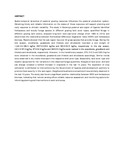Spatio temporal dynamics of forage and land cover changes in Karamoja sub-region, Uganda

View/
Date
2014Author
Egeru, Anthony
Wasonga, Oliver
Kyagulanyi, Joseph
Majaliwa, GJ Mwanjalolo
MacOpiyo, Laban
Mburu, John
Language
enMetadata
Show full item recordAbstract
Spatio-temporal dynamics of pastoral grazing resources influences the pastoral production system. Obtaining timely and reliable information on the status of these resources will support planning and early response to climatic variability. This study in Karamoja pastoral sub-region of Uganda identified herbaceous and woody forage species in different grazing land cover types, quantified forage in different grazing land covers, analyzed long-term land use/cover change (from 1986 to 2013) and determined the relationship between Normalized Difference Vegetation Index (NDVI) and herbaceous biomass. Results showed that the sub-region has over 30 grass species that provide forage. During the wet season, woodlands, grasslands and thickets and shrublands recorded a wet weight of 1,342.5 ± 104.5 kg/ha, 857.5 ± 29.4 kg/ha and 501 ± 43.9 kg/ha, respectively. In the dry season, 542.5 ± 57.6 kg/ha, 273 ± 6.4 kg/ha and 140 ± 9.2 kg/ha were realized in the woodlands, grasslands and thickets and shrublands, respectively. However, in the transitionary season, 276, 512.5 and 529.2 kg/ha were obtained in the woodlands, grasslands and thickets and shrublands accordingly. Similar trends were observed in dry matter biomass in the respective land cover type. Seasonality, land cover type and location accounted for the variations in the observed forage quantities. Analysis of land cover and land use change revealed a tenfold increase in croplands in the last 13 years. The expansion of crop cultivation is attributed to interventions by the Government of Uganda and development partners to promote food security in the sub-region. Heightened bushland encroachment was similarly observed in the last 13 years. The study also found a significant positive relationship between NDVI and herbaceous biomass, indicating that remote sensing offers reliable resource assessment and monitoring options for informing planning and interventions in semi-arid areas.
Citation
Pastoralism: Research, Policy and Practice 2014, 4:6Publisher
University of Nairobi,
Description
ARTICLE
